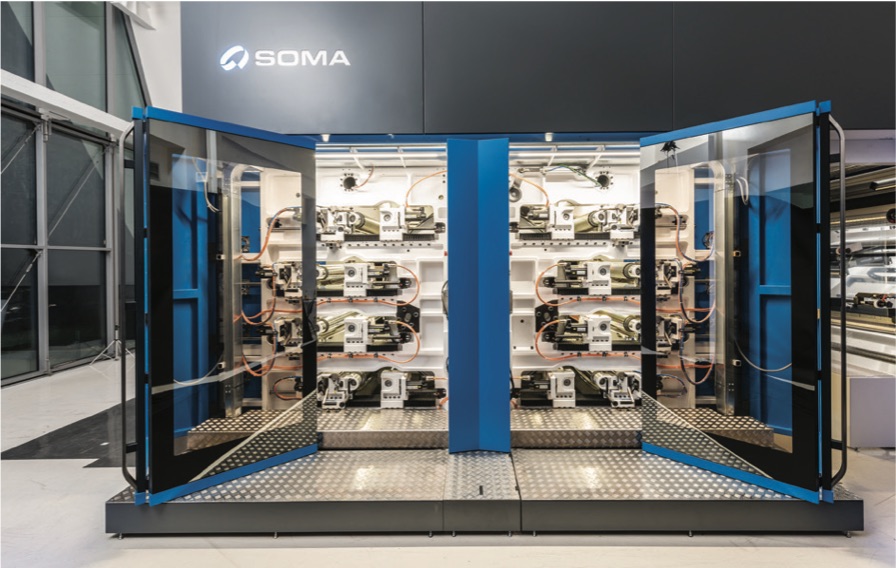Eliminating Bounce
- Published: May 23, 2022
On a Flexo Press There’s No Such Thing as Good Vibrations
By Garrett Taylor, SOMA US and Canada Sales Director
Although modern flexo presses print at such high speeds, there is still a phenomenon that won’t allow the operator to reach desired printing speeds or production of great work economically: press bounce. Bounce, or vibration, is one of the biggest challenges that we face in flexographic printing.
More common in older flexo presses, press bounce often happens when the plate hits and bounces off the substrate, and then returns to print. Most of us recognize this as banding. The lines will seem to show up across the web direction, but not necessarily in the same place on the design every time. Depending upon the graphic design, it could happen with all printing units, or may be visible on one color only. Very simply, flexo presses are less productive because the speed must be adjusted, or in worst case decelerated to avoid bounce.
Plate bounce could be caused by the working condition of the press, printing form design or repeat length. Beyond adjusting the press speed, there are a number of workarounds, but they are usually temporary. They include working with designs or imposing plates to reduce the effect of bounce, or experimenting with tape, the plates or anilox. Some people even suggest that special cylinders will help reduce bounce effects. Another possibility that could help is changing the doctor blades.
While reduced print quality is the immediate effect, often complete print failures occur. If this persists, it may even harm the printing system. Neither is desirable and, in the worst short-term scenario, the entire job may have to be reprinted. There can be increased wear of ancillary parts, which subsequently costs printers even more money in the long run. To make a long story short, bouncing makes printers lose money.
On the other hand, controlling bounce on a flexo press maintains job consistency — particularly when using high definition plates — at very fast speeds during the press run. It can also assure that the press can hold stable highlight dots with exceptional registration.
This opens the door for new print process ideas, such as expanded gamut printing —which, as we know, limits the need for washouts between jobs.
One obvious way to resolve bounce is to produce a press that is inherently stable. There are ways to do this with hardware and software solutions.

Everything is Solid
In terms of a printing press, there are several systems that can guarantee consistent printing — mainly mechanical press properties. Done right, they can guarantee maximum speeds and minimize bounces. Thus, it maintains dynamic stability during the printing process, resulting in a perfect dot, with exceptional registration.
Some presses are built with an important objective of reducing vibration in the print deck. It starts with a solid foundation. The best way is to build two cast-iron single-block side frames, where the complete side of the print module is cast, annealed, machined, painted and assembled as a whole. This provides optimal rigidity and damping capabilities. It may also have a reinforced insert for drum mounting. Printing unit frames are key press parts developed and designed with great emphases on optimal dynamics, rigidity and damping. Some of these frames can be nearly 8 inches thick in places.
Decks with print and anilox cylinders can be designed with emphasis on firmness, precision and reliability. The bounce reduction capabilities of composite carbon fiber are well known. Innovative mandrel housings for the print and anilox decks can sit on a ‘slideway’ guide, positioning the printing deck design directly on the frame, and not a separate rail. This ensures that there is rigidity and minimum vibration in the printing decks.
With these features, a press can reliably and consistently hold highlight dots with perfect registration, minimizing bounces at high speeds. It also delivers optimum vibration damping for HD quality print.
Ready for a Tune-up
Flexo presses have become very sophisticated digitally. The drive mechanisms already analyze performance. Other components include software that tunes the drive motors to minimize the bouncing effect while reaching perfect registration.
Using a specially designed software algorithm performed during job set up, print properties are analyzed and the bouncing effect can be minimized for each particular design. It takes into consideration the dynamic effects of the bridge, the sleeve, the tape and the design itself. This leads to less vibration and bounce while reaching better registration.
It’s quite a revolutionary technology that can bring control of printing stability to higher level of precision. By addressing the majority of concerns for bounce, this assures exceptional quality — at extremely fast speeds.
This is, of course, the ultimate objective of a flexo press — outstanding quality at extremely productive speeds. It helps a package printer deliver eye-catching products for the shelf, while offering quick time-to-market without the fear of re-dos. That will promise good vibes to the brand owner.
About the Author
Garrett Taylor, SOMA US and Canada Sales Director, can be reached at This email address is being protected from spambots. You need JavaScript enabled to view it.. Learn more about SOMA, producer of flexographic printing presses, plate mounters, laminators and slitter rewinders at www.Soma-eng.com.



